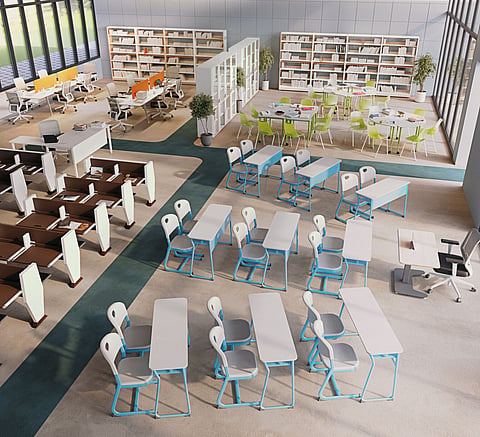

In today's rapidly evolving global landscape, the education sector faces an unprecedented challenge: Preparing students for a future job market that is constantly shifting.
The professionals of tomorrow will need to excel in creativity, critical thinking, problem-solving, collaboration, and adaptability — competencies that cannot be cultivated through traditional rote learning and standardised testing alone.
This reality necessitates a fundamental reimagining of our educational environments and methodologies.
The new paradigm of learning spaces
The concept of the classroom is undergoing a radical transformation. Research indicates that 79% of students express a desire to rearrange furniture to suit their individual needs and facilitate group discussions.
This insight underscores the importance of creating flexible, tech-enabled spaces that support both individual and collaborative learning.
Modern learning environments should be designed to:
Foster engagement: By creating inviting, relaxing, and invigorating spaces, educators can stimulate curiosity and encourage active participation.
Enhance safety and well-being: Certified designs with minimal VOC emissions ensure better indoor air quality, creating healthier and safer learning environments.
Promote ergonomic health: Furniture that adapts to students' growth and energy levels can improve concentration and overall well-being.
The ergonomic advantage
Ergonomics plays a crucial role in creating effective learning spaces. The widely accepted 90-90-90 rule suggests that optimal posture is achieved when the back and thighs form a 90-degree angle, as do the knees, and the feet and ankles. This posture reduces discomfort and enhances focus.
Key considerations for ergonomic learning spaces include:
Adjustable seat height and armrests to accommodate different body profiles
Proper thigh support and back support
Accessories like external keyboards, mouse devices, and laptop stands to ensure neutral neck postures
Technology integration: The future of learning
As we transition into an increasingly digital age, the integration of technology in learning spaces is no longer optional — it's imperative. Tech-enabled furniture solutions can create smart, interactive environments that seamlessly blend physical and digital learning experiences.
This approach not only enhances collaboration and facilitates interactive teaching methods but also prepares students for the tech-driven workplaces of the future.
Measurable impact
The effectiveness of modern learning space design is evident in empirical data. Studies show that 94% of teachers who can change their classroom layout agree they can teach effectively, compared to only 40.5% in static environments.
Moreover, educational institutions report significant improvements in students' concentration levels, engagement, and overall comfort after implementing ergonomic furniture and flexible layouts.
A collaborative approach to education design
The future of education lies in collaboration between educators, designers, and industry experts. Key aspects of this collaborative approach include:
Customisation: Tailored solutions that meet the specific needs of different learning spaces, from primary schools to higher education institutions.
Flexibility: Furniture and spaces that can be easily reconfigured to accommodate various teaching styles and learning activities.
Sustainability: Emphasis on eco-friendly materials and designs that promote student well-being and environmental responsibility.
Looking ahead
As the education sector continues to evolve, the focus must remain on creating learning environments that nurture 21st-century skills. The shift from monologue to collaborative learning, and from content-based to experiential learning, is crucial in shaping a new generation of thinkers, innovators, and leaders.
Redefining the learning experience goes beyond changing furniture or incorporating technology — it's about revolutionising the entire approach to education. It involves creating spaces where students can explore, collaborate, and develop the skills they'll need in an uncertain future.
By focusing on flexibility, ergonomics, technology integration, and student-centered design, we can create educational environments that not only meet the needs of today's learners but also adapt to the challenges of tomorrow.
As we move forward, it's essential that all stakeholders in education —from policymakers and administrators to teachers and designers — work together to create these innovative learning spaces.
By doing so, we can ensure that our educational systems are not just keeping pace with the changing world, but are actively shaping it, preparing students to become the adaptable, creative, and critical thinkers that the future demands.
(The author of this column Sameer Joshi is the Senior Vice-President (B2B) of Godrej Interio. Views expressed are his own.)
